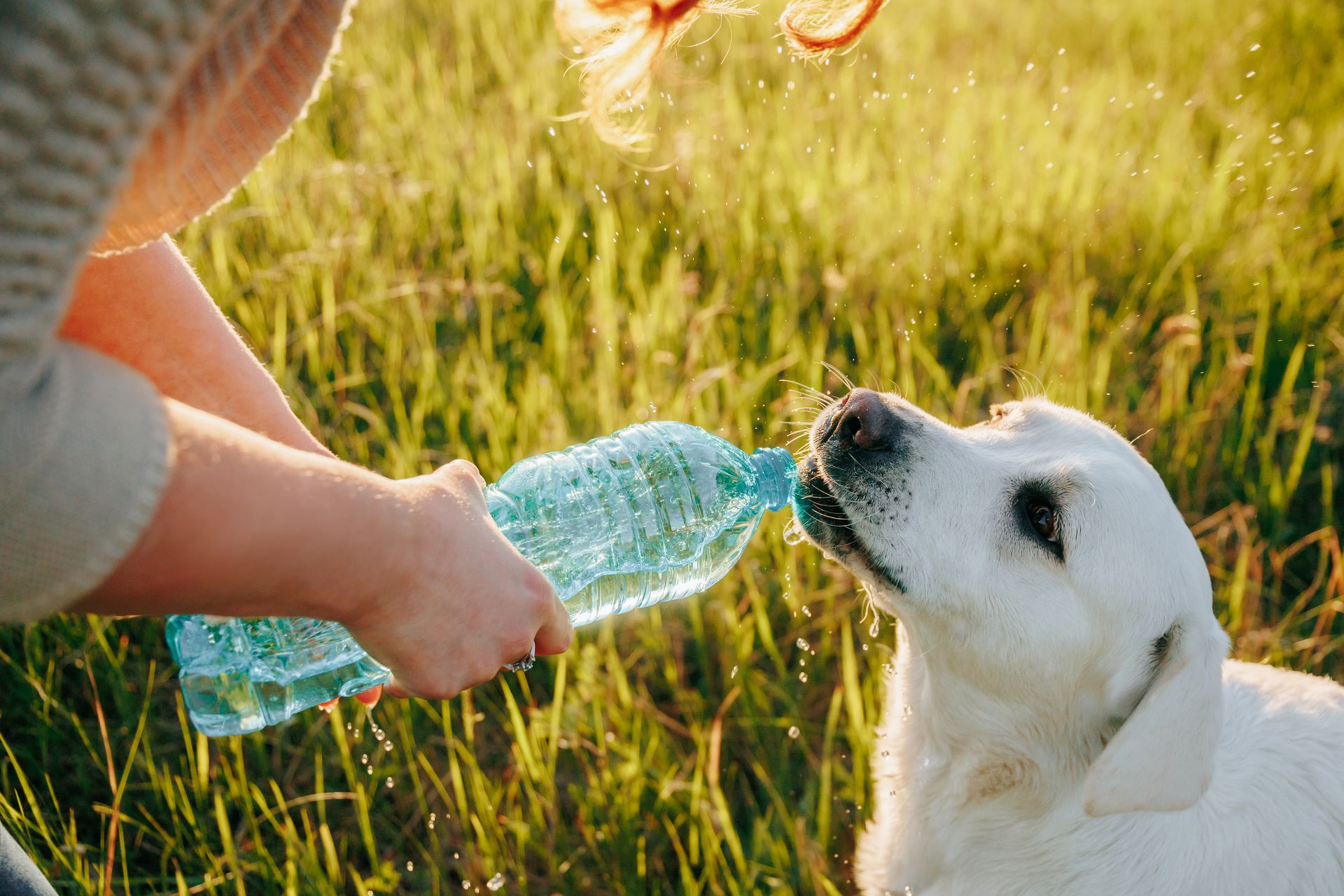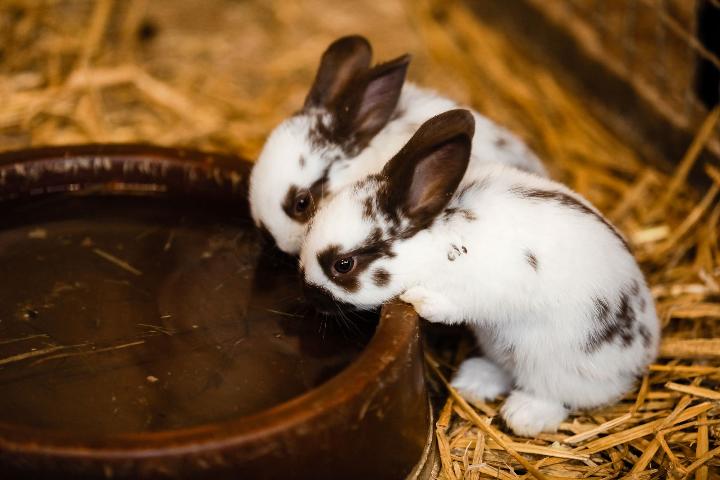July is National Pet Hydration Awareness Month. Why do we need a month dedicated to pet hydration? Well...
As veterinarians and veterinary technicians, you understand the why hydration is so important for your patients. You see firsthand the consequences of dehydration, from the early signs of lethargy and dry gums to more severe conditions like kidney disease and heat stroke. Our goal this month is to support your efforts in raising awareness and providing the best care for our beloved pets.
Consider the daily water requirements for your most common patients, dogs and cats:
- Dogs need about 1 ounce of water per pound of body weight each day
- Cats require around 3.5 to 4.5 ounces of water per 5 pounds of body weight.
Despite these needs, dehydration remains a common issue, often leading to significant health problems.
Chronic dehydration can contribute to kidney disease, affecting about 30% of cats over the age of 10. Similarly, dogs can suffer from urinary tract infections and heat stroke when they don’t get enough water, especially during hot weather.
Statistics show that around 25% of pet owners are not aware of their pets’ specific water intake needs. This lack of awareness highlights the necessity of National Pet Hydration Awareness Month. By working together, we can educate pet owners on the importance of hydration and how to ensure their pets receive adequate water.
We appreciate the vital role veterinary professionals play in the health and well-being of pets. And during this month, we want to advocate alongside you, supporting your efforts to keep pets healthy and hydrated.
Let’s use this month to amplify the message of proper hydration, ensuring every pet receives the care they need to thrive.

Why we need pet hydration awareness month
It’s an important reminder of the need to keep our beloved pets well-hydrated. Here's why dedicating a month to this cause is so crucial:
Raising Awareness
Many pet owners aren't fully aware of how critical proper hydration is for their pets. Pet Hydration Awareness Month helps educate them on the specific hydration needs of different types of pets.
Preventing Health Issues
Dehydration can lead to severe health problems, including kidney disease, urinary tract infections, and heat stroke. Chronic dehydration is a leading cause of kidney disease in cats, affecting approximately 30% of cats over the age of 10. Dogs are at higher risk of urinary tract infections and heat stroke when dehydrated, particularly in hot weather.
Encouraging regular monitoring
Pet owners may not consistently monitor their pets' water intake. This month serves as a reminder to keep an eye on how much water pets are drinking. Ensuring pets have access to fresh, clean water at all times is essential for their health.
Promoting best practices
Sharing tips and best practices helps pet owners implement effective strategies for keeping their pets hydrated. This includes providing water fountains, offering wet food, and incorporating hydrating treats.
Addressing myths and misconceptions
There are many myths about pet hydration. This awareness month provides an opportunity to debunk these myths and share accurate information.
Myth: "Cats don’t need much water because they originated from desert animals."
Fact: While cats can survive on less water, they still need adequate hydration to prevent health issues.
Highlighting special needs
Different pets have different hydration requirements. This month focuses on the specific needs of various pets, from active dogs to cats with urinary issues and reptiles needing misting.
Special cases: Senior pets, puppies, and pets with chronic conditions may have higher hydration needs.
Encouraging veterinary check-ups
Regular check-ups can help detect early signs of dehydration or related health issues. This month can encourage pet owners to schedule these important visits. Veterinarians can offer personalized advice and recommendations for maintaining proper hydration.
Supporting overall pet health
Hydration is a key component of overall pet health and well-being. By focusing on hydration, pet owners are reminded of the broader picture of pet care, including nutrition, exercise, and regular health check-ups.
Engaging the community
Pet Hydration Awareness Month brings together veterinarians, pet stores, and animal welfare organizations to promote a common cause.
Collective efforts can have a more significant impact on raising awareness and improving pet care practices.

Myths and facts about pet gydration (and dehydration)
When it comes to keeping our pets hydrated, there are plenty of myths and misconceptions floating around. Your patients might bring them up to you during their regular visits, and it’s important to set the record straight when they do.
Myth #1: "Cats don't need much water because they originated from desert animals."
Fact: While it’s true that cats' ancestors lived in arid environments, modern domestic cats still need a consistent supply of water to stay healthy. Cats are prone to urinary tract issues and kidney disease, which can be exacerbated by inadequate hydration. Ensuring your cat has access to fresh water and considering wet food as part of their diet can significantly improve their hydration status.
Myth #2: "Dogs only need water after exercise."
Fact: Dogs need access to fresh water all day, not just after physical activity. Dogs lose water through panting, and their bodies need a regular supply of water to maintain essential bodily functions. Keeping water bowls filled and accessible, especially in multiple locations, ensures they stay hydrated throughout the day.
Myth #3: "My pet will drink when they're thirsty; I don’t need to worry."
Fact: Pet owners may not consistently monitor their pets' water intake. This month serves as a reminder to keep an eye on how much water pets are drinking. Ensuring pets have access to fresh, clean water at all times is essential for their health.
Myth #4: "Pets don’t need more water in the winter."
Fact: Dehydration isn’t just a summer issue. Pets can become dehydrated in winter, too, especially in heated indoor environments where the air is dry. Always ensure your pets have access to water year-round and monitor their intake, regardless of the season.
Myth #5: "All pets can drink from the same bowl."
Fact: While sharing a water bowl might seem convenient, it’s not always ideal. Different pets have different needs, and some may dominate the bowl, preventing others from drinking enough. Additionally, shared bowls can spread illnesses. Providing separate water sources for each pet ensures everyone stays hydrated and healthy.
Myth: "Cats don’t need much water because they originated from desert animals."
Fact: While cats can survive on less water, they still need adequate hydration to prevent health issues.
Myth #6: "Adding salt to water encourages pets to drink more."
Fact: Adding salt to your pet’s water can actually be harmful. Excessive salt intake can lead to increased thirst and, subsequently, potential dehydration as the body tries to balance salt levels. Always offer plain, fresh water without any additives.
Myth #7: "If my pet eats wet food, they don't need to drink much water."
Fact: While wet food does contribute to your pet’s overall water intake, it doesn’t eliminate the need for fresh water. Pets should still have access to clean water at all times, regardless of their diet. Wet food helps, but it’s not a substitute for drinking water.
Myth #8: "Pets won’t get dehydrated if they’re indoors all day."
Fact: Even indoor pets can become dehydrated, especially if the indoor environment is dry or if they are not drinking enough water. It’s crucial to ensure that indoor pets have constant access to fresh water and to monitor their hydration status regularly.
Myth #9: "Puppies and kittens don’t need as much water as adult pets."
Fact: Puppies and kittens are actually more prone to dehydration due to their smaller size and higher energy levels. They need frequent access to water, and their hydration levels should be monitored closely to ensure they’re getting enough.
Myth #10: "Hydration isn’t important for reptiles and amphibians."
Fact: Reptiles and amphibians have specific hydration needs that are just as crucial as those of mammals. Many reptiles require misting or soaking to stay hydrated, and amphibians need moist environments to thrive. Ignoring their hydration needs can lead to serious health issues.
By debunking these common myths and understanding the true facts about pet hydration, pet owners can take better care of their furry, feathered, and scaly friends.

Signs of dehydration in the most common pets in North America
Many of the signs of dehydration appear similar across different species of pet. Here is a quick reference of the most common symptoms for the pets families in North America choose to adopt:
Dogs:
- Loss of skin elasticity
- Gently pinch the skin on the back of their neck. If it doesn’t snap back quickly, they might be dehydrated.
- Dry nose and gums
- A dehydrated dog’s nose may be dry, and their gums can be sticky or tacky to the touch.
- Lethargy
- Dehydrated dogs often appear tired and have less energy.
- Sunken eyes
- Their eyes may appear dull and sunken.
- Excessive panting
- Increased panting can be a sign of dehydration, especially if combined with other symptoms.
Cats:
- Loss of skin elasticity
- Pinch the skin between the shoulders; slow return can indicate dehydration.
- Dry nose and gums
- Dry, sticky gums are a common sign.
- Lethargy
- Dehydrated cats may show less interest in their usual activities.
- Decreased appetite
- A lack of interest in food can signal dehydration.
Small mammals (Rabbits, Guinea Pigs, Hamsters, Ferrets)
- Loss of skin elasticity
- These pets may become unusually inactive.
- Dry nose and mouth
- A dry, tacky mouth is a common sign.
- Sunken eyes
- Their eyes may look sunken.
- Reduce urination
- Noticeable decrease in urination or dry fecal pellets.
- Poor skin elasticity
- Pinch the skin gently; slow return indicates dehydration.
Birds
- Fluffed feathers
- Birds may fluff their feathers and appear less sleek.
- Sunken eyes
- Eyes can appear dull and sunken.
- Dry beak and skin
- Beak and exposed skin may feel dry.
- Lethargy
- Dehydrated birds often have reduced activity levels.
- Weight loss
- Noticeable weight loss can occur with dehydration.
Reptiles (Lizards, Snakes, Turtles)
- Wrinkled skin
- Their skin may appear wrinkled or loose.
- Sunken eyes
- Eyes may look sunken.
- Lethargy
- Reduced activity and movement.
- Dry mouth
- A dry, sticky mouth and gums.
- Decreased appetite
- Less interest in food.
Amphibians
- Dry skin
- Their skin may become dry and less moist.
- Sunken eyes
- Eyes may look sunken.
- Lethargy
- Reduced movement and activity.
- Loss of appetite
- Decreased interest in food.
- Sticky skin
- Skin may feel sticky to the touch.

Make a pet hydration a priority everyday
As we celebrate National Pet Hydration Awareness Month, it's important to recognize the critical role hydration plays in the health and well-being of our pets. From dogs and cats to birds and reptiles, every pet has unique hydration needs that must be met to keep them healthy and happy.
Understanding the signs of dehydration, knowing the specific needs of different pets, and debunking common myths are all steps toward ensuring our pets receive the proper care. Whether you're a veterinarian educating pet owners or a pet parent striving to do your best, staying informed about pet hydration is crucial.
As we wrap up this month of awareness, let's continue to advocate for pets' hydration needs all year round. By doing so, we can prevent many health issues and ensure our pets live long, happy, and healthy lives. Let's make every month a pet hydration awareness month and toast to the well-being of our furry, feathered, and scaly friends!
Thank you for joining us in this important cause. Stay hydrated, and keep those water bowls full!
